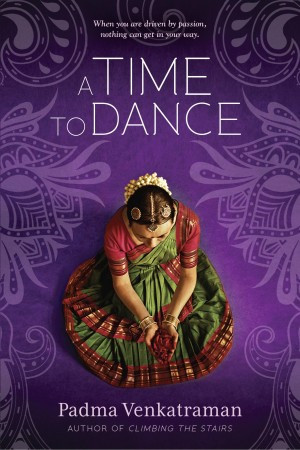Padma Venkatraman’s novel, A Time to Dance, tells the compelling story of Veda, a young dancer whose life takes an unexpected turn after a car accident. On her way home from a dance competition, Veda’s world is abruptly altered, leading to the amputation of her right leg below the knee. This life-changing event sends shockwaves through her passion for dance when her dance teacher suggests she might need to find a “new dream.”
“Veda, so many of us
blessed
with able bodies
can’t meet the demands of a professional dancer’s life.
Maybe for you
it’s time
for a new dream.”
These words mark the beginning of Veda’s journey of resilience, self-discovery, and redefining what it means to dance. Initially, the prospect of reading a book centered around a dancer losing a leg might evoke concerns about potentially stereotypical portrayals of disability. However, A Time to Dance gracefully transcends these expectations. It avoids sensationalism and instead offers a nuanced and authentic exploration of Veda’s experience.
 Cover for A TIME TO DANCE
Cover for A TIME TO DANCE
Veda is not depicted as a symbol of pity or merely an inspirational figure designed to evoke able-bodied readers’ emotions. She emerges as a fully realized character – a relatable teenager grappling with complex emotions, navigating relationships with family and friends, and confronting an immense personal challenge with remarkable strength. Venkatraman masterfully portrays Veda’s journey, making her experiences resonate deeply with readers.
A Realistic Journey of Healing and Adaptation
One of the most striking aspects of A Time to Dance is its unflinchingly realistic depiction of life as an amputee. The novel delves into the physical and emotional realities of amputation with remarkable accuracy. From the initial shock and grief to the ongoing challenges of phantom pain, scar pain, and learning to navigate the world with a prosthetic leg, Venkatraman’s writing is both sensitive and informative.
The detailed descriptions of Veda’s interactions with her prosthetist, Jim, further enhance the book’s authenticity. For instance, the scene where Jim creates a mold of Veda’s residual limb using plaster of Paris is a testament to the author’s meticulous research and commitment to accuracy. These details are not just technicalities; they ground Veda’s emotional journey in tangible realities, making her experiences even more impactful.
My phantom comes alive.
Beneath my right knee,
Nails scratch at invisible skin.
The emotional landscape of amputation is explored with equal depth. The reviewer of the original article, an amputee themselves, attests to the book’s power to evoke their own experiences. The raw emotions of confronting the changed body, the “nothingness” where a limb once was, are portrayed with visceral honesty. This level of representation is rare and profoundly valuable, offering readers a genuine glimpse into the lived experience of amputation.
I see an ugly bulge under the sheet covering my legs.
Yank off the sheet with what’s left
of my strength.
My right leg ends
in a bandage.
Foot, ankle, and nearly half of my calf,
gone.
Chopped
right off.
“No!” The nurse pulls my sheet
back over the leftover
bit of my right leg.
But I still see the
nothingness
below my right knee.
Veda Beyond Her Disability: A Teenager’s Universal Story
While A Time to Dance thoughtfully addresses disability, it is crucial to recognize that Veda’s story extends far beyond this single aspect of her identity. Venkatraman crafts Veda as a multi-faceted teenager with relatable experiences. She navigates friendships, family dynamics, and budding romantic interests. These elements of her life are not overshadowed by her amputation but are interwoven into the fabric of her journey, demonstrating that disability is one facet of a rich and complex life.
The book beautifully portrays Veda’s resilience as she adapts to her new reality. Her determination to return to dance is not presented as an extraordinary feat of inspiration but as a natural extension of her passion and identity. This subtle yet significant distinction avoids reducing Veda to a symbol and instead celebrates her individual strength and perseverance. Her story becomes relatable to any teenager facing adversity, highlighting the universal themes of adaptation, self-acceptance, and pursuing one’s dreams despite challenges.
The Importance of Role Models and Representation
A Time to Dance also underscores the vital role of representation and role models, particularly for young people with disabilities. In a pivotal scene, Veda learns about famous amputee dancers from her prosthetist, Jim. He displays pictures of these dancers in his office, serving as a powerful source of inspiration for Veda. This moment is transformative for her, allowing her to envision a future where her disability does not preclude her from achieving her dreams in dance.
“I dream of my picture hanging next to Sudha Chandran’s,”
This aspect of the book is particularly significant. It showcases the profound impact that disabled role models can have on young people, providing them with tangible examples of success and possibility. By seeing others who have navigated similar challenges and achieved greatness, Veda gains confidence and renewed motivation to pursue her passion. This representation is not just inspirational; it is validating and empowering.
A Note on Terminology: Embracing the Language of Disability
The original review raises a valid point regarding the book’s use of the term “differently abled.” While intended to be kind, this term is not widely embraced within the disabled community. The review highlights that many disabled individuals identify with the term “disabled” and do not perceive it as negative. This nuanced discussion is important for authors and readers alike, encouraging a deeper understanding of disability terminology and the preferences within the community. While this is a minor critique within an otherwise excellent book, it serves as a valuable learning opportunity regarding inclusive language and representation.
Conclusion: Finding Your Dance
A Time to Dance is a powerful and moving novel that resonates deeply on multiple levels. It is a story about dance, but more profoundly, it is a story about resilience, identity, and the courage to redefine oneself in the face of adversity. Veda’s journey is not just for dancers or those familiar with disability; it is a universal narrative about finding your rhythm in life, even when the beat changes unexpectedly.
By the end of the book, Veda embodies a sense of disability pride, comfortable in her own skin and embracing her unique journey. Her transformation is inspiring, not because she overcomes a tragedy to dance again, but because she reclaims her passion on her own terms, demonstrating that dance is truly about what you feel inside. A Time to Dance is a highly recommended read for anyone seeking a story that is both emotionally resonant and genuinely representative, reminding us all that there is always a time to dance, regardless of life’s unexpected turns.

